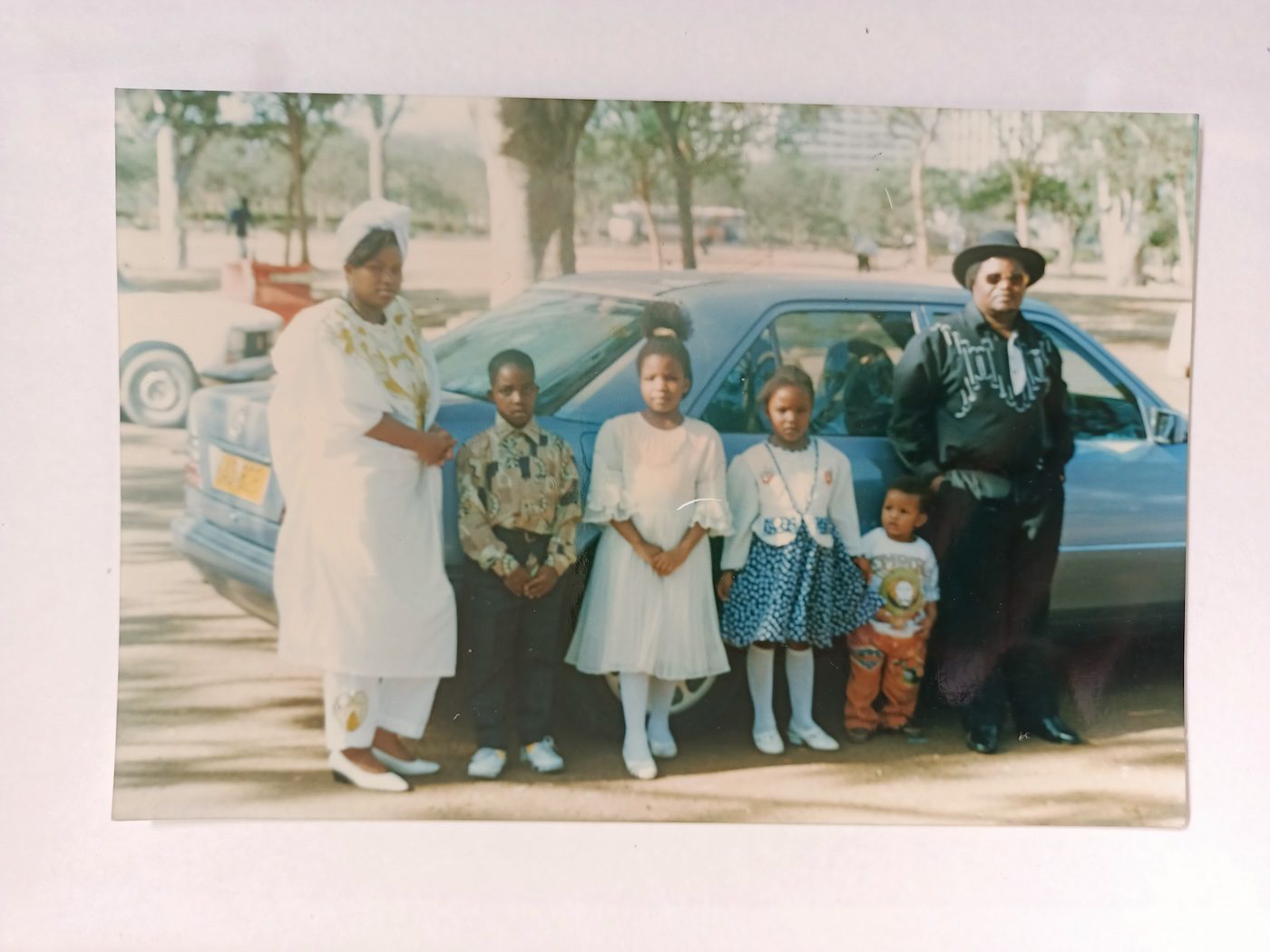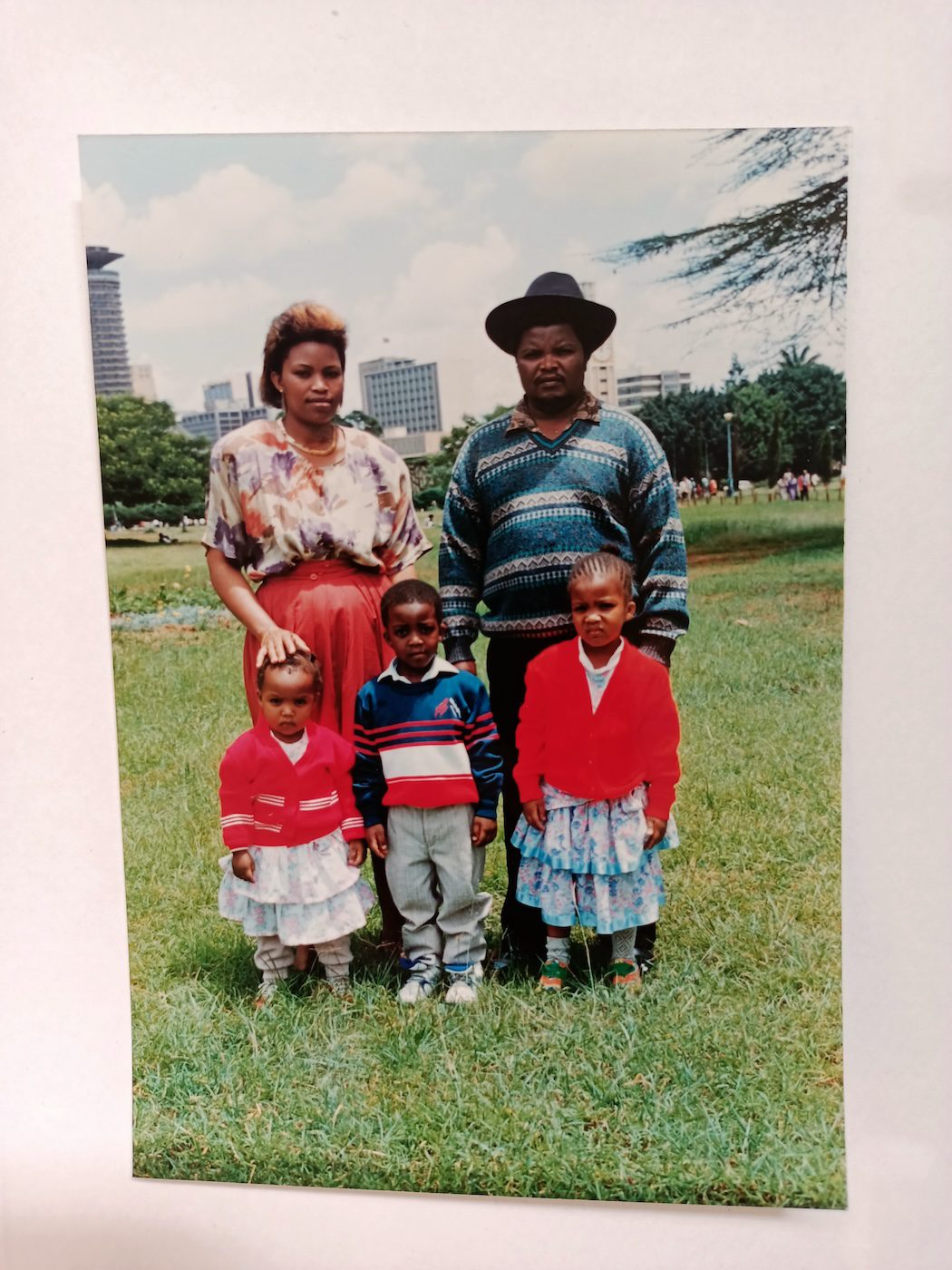In her contribution, Mwende Ngao explores the complex relationship between urban life and nature in a rapidly developing Nairobi.

Mwende and Mwendwa Ngao.
Uhuru, Uhuru!
At long last,
Uhuru!
I have these wonderful memories of family Sundays as a child. We’d troop to church and then go to Uhuru Park immediately after for ice-cream and pictures. I have this distinct memory of jumping up and down while tugging at my mom’s dress sleeves begging her to wrap up her long greetings with other parishioners in the parking lot. My dad would be the one to save me and my siblings with a honk and wave for us to hurry as he was holding up the exit. We’d rush to the car as my mom politely apologised to those behind us in their cars that we’d held up at the gate, and off we’d go to my favourite place in my world.
I don’t recall the first time I went to Uhuru Park. I do, however, recall the awe I felt in our many outings there. The grass was greener than any of the green I’d seen. Greener than the sukuma wiki we had on most days. Greener than the crayons I used to colour in my stick figure drawings in school. Greener than my mom’s favourite church dress. We had picnics on that green grass, took family pictures, enjoyed boat rides, played and prayed. It was magical. I sometimes leaf through the family albums from that time whenever I visit my parents, and smile at all that joy I once had.
Uhuru Park was opened to the general public by the late Mzee Jomo Kenyatta on 23 May1969. It is a 32-acre recreational park adjacent to the Central Business District (CBD) of Nairobi and contains an artificial lake, several national monuments, and an assembly ground. It is prominently featured in pivotal moments of Kenyan history including Jomo Kenyatta’s funeral service in 1978, Wangari Maathai’s protest against a plan to build a 60-story Kenya Times Media Trust Complex in Uhuru Park in 1989 and numerous political rallies and protests over the years.
Our Sundays at Uhuru Park became less frequent as we moved houses and my parents became interested in trying new places. Soon the Sunday tradition shifted from picnics at the park to lunches by the pool. I discovered other shades of greens and discovered other colours too and the park suddenly seemed dull. Eventually, it became a place I only heard about on the news. There was a rally. Or prayers. And the police. Always, the police.
They shot Kenya’s children
for asking for their country
to love them back.

Mwende Ngao and Family (Mwende and siblings) – 1992. © Mwende Ngao
The park is different when I see it filled with Kenyans singing freedom songs on a rainy July afternoon this year (1). In a sea of waving flags, I can see the green peaking out. Defiant and steady. I weep with joy at the sight of t. It’s a green that rings of community and camaraderie and courage. That we lived to see this day. That we lived to know this was possible. That we stand where those that came before us stood for a better Kenya. It’s the green of freedom.
Mother Nature loves her children.
She loves them with an uncontrollable fierceness.
Nairobi is an ugly city when it rains. The rain always rudely reminds us that it indeed is a swamp, and lately, the weather has become increasingly unpredictable. Climate change won’t leave any of us unpunished. Even those of us who didn’t contribute our fair share to the damage. The sin is being human. Or being alive on this rock hurtling through space. They cut down my favourite row of trees. The Jacaranda propaganda (2) is on its deathbed. The city is getting hotter. The shade cover is smaller. The people angrier.
The name “Nairobi » comes from the Maasai phrase ‘Enkare Nyrobi’, which translates to “cool waters”. Originally a swamp, Nairobi got on the map when a supply depot of the Uganda Railway was built by the British in 1899 linking Mombasa to Uganda. The site was identified by Sir George Whitehouse for a store depot, shunting ground and camping ground for the Indian labourers working on the railway, favouring it as an ideal resting place due to its high elevation, temperate climate, and adequate water supply. His choice was, however, criticised by officials within the Protectorate government who felt the site was too flat, poorly drained and relatively infertile. Looking back now with the devastating floods plaguing the city, they weren’t entirely wrong.
Look up at the sky and make a wish.
I wish I could undo the past.
I know, but the past is already written, choose something else.

Mwende Ngao and Family (Parents and kids) – 1997. © Mwende Ngao
What is nature in a city that is rapidly developing? The President and the Governor said we need to make room for development; that to be a world-class city demands high-rise buildings. Don’t we want to develop? They reopened Uhuru Park after an extended closure and they say there’s still more renovations to come. Perhaps a nightclub. Restaurants. More amenities. They want private partners to invest. I went to see it when they opened it up. I had not been there since before the pandemic. What’s that? 4 years? It felt longer. The grass isn’t as green.
My therapist says I need to go outside and commune with nature. That I need sun and fresh air. I work remotely so I spend the majority of my time cooped up in my apartment. Sometimes cooped up in my room. The work is demanding and isolating and contrary to popular belief, I can’t do what I want when I want. Maybe I can listen to music. I can wear pajamas all day. I can work from inside my bed. I can make endless cups of tea. But I just can’t go outside to get some sun in the middle of the day.
I tried to take walks when I could. Early mornings. The cars were loud. The people were many, all heading to work. The harassment was unnerving. It was impossible to make it past 100 metres without a stranger of a man attempting to make conversation or leering. A few times I almost got run off the road by matatus. I could barely hear myself above the chaos. I could barely commune with myself, let alone commune with nature. I don’t live in the suburbs. I’m not lucky enough. I told myself I could wait for the weekends and go to Arboretum or Karura. And I did. But the distance and cost became too much. I was increasing my anxiety to fight my anxiety.
Daughter Earth, pick flowers and forget your worries.

Mwende Ngao and Family (parents and kids) – 1993. © Mwende Ngao
I have a recurring daydream. I wake up in a room bathed in light. I open my window and look outside and see the greenest green I have ever seen of trees as far as the eye can see. I grab my morning coffee and go outside. I sit on the green grass and take in the fresh air and enjoy the feel of sun on my skin. Later in the day, I go for a walk and the pedestrian paths are actually for pedestrians. I walk past beautiful Jacaranda trees and marvel at how beautiful the purple is. When it rains, I listen to the beautiful sound. I am not filled with dread of floods or assaulted by the smell of sewage.
Where do Nairobians go to experience nature? They reclaim every patch of grass. Even roundabouts. Families picnic where they can, like mine used to do. How do you heal in nature when you can barely access it? You don’t. How do you live in a city that is hostile to nature? You just do.
I can’t remember the last time my naked feet felt some grass. Maybe at a wedding last year. It was a fleeting moment. When did the simplest pleasures become so much work to experience? The best of this city is paid for. And unfortunately, the kind of green required I don’t have enough of.
This text is part of the Stedelijk x C& Editorial Fellowship: To Spring From Salted Earth edited by Wanini Kimemiah.
Mwende Ngao is a writer and filmmaker working at the intersection of tech, media and culture.
(1) Ouma,Charles,“Kenyans killed during demos honoured at Shujaa Memorial Concert as stars dazzle at Uhuru Park”, 7 Jul. 2024 https://www.pulselive.co.ke/news/local/shujaazmemorialconcertgen-z-honour-kenyans-killed-during-demos-at-uhuru-park/p4bvwyy
(2) Kuo, Lilly “Nairobi’s jacaranda season is a reminder of the city’s beauty—and the need to protect it” Quartz Magazine, 11 Oct. 2016 https://qz.com/africa/805631/photos-nairobis-jacarandas-are-a-reminder-of-the-citys-beauty-and-the-need-to-protect-it
STEDELIJK X C& EDITORIAL FELLOWSHIP: WANINI KIMEMIAH
More Editorial